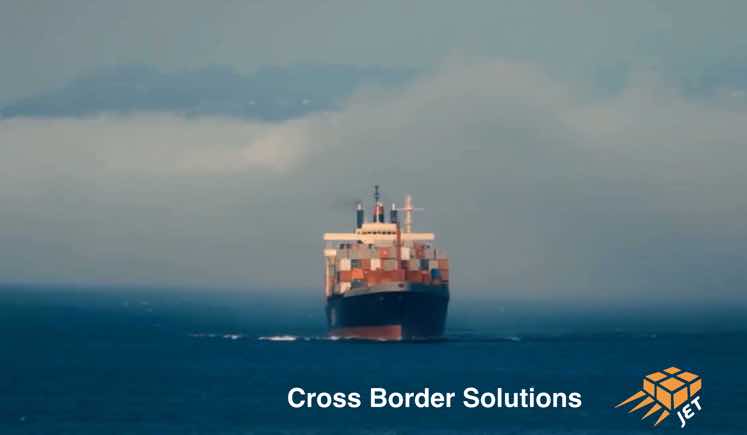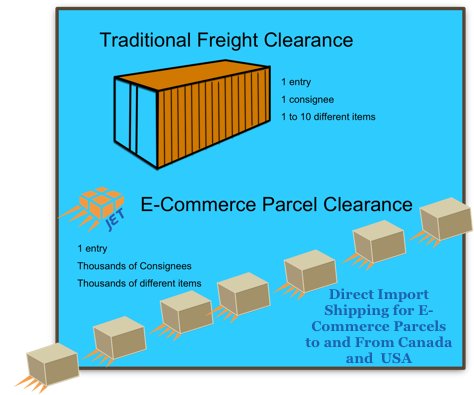
Parcels in Containers: The Cross Border e-commerce Opportunity
Among global markets, Canada stands out as great opportunity for online retailers. The Canadian e-commerce market offers opportunities for growth. A requires a strategic approach to ensure smooth and successful transactions. In this blog, we'll delve into the key considerations and tips for shipping e-commerce orders to Canada.
International shipping from the U. is available for customers worldwide. S. To Canada, FedEx (Source: www.fedex.com)
Canadians have shown a willingness to shop with U.S. businesses, with Costco, Walmart, and Lowe's being among the country's top retailers. Small businesses have also experienced success, particularly with platforms like Etsy. (Source: www.fedex.com)
After conducting some preliminary research, there are a few essential steps to take before expanding to Canada. First and foremost, it is crucial that your brand's digital platform accurately reflects Canada's currency and accounting of duties and taxes. It's essential to provide language choices as a second point. Any website selling products to Québec residents is required by Québec language laws to include both French and English. (Source: www.fedex.com)
To get your product in customer's hands across the border, you need to understand shipping policies and processes once your online marketplace is compliant with Canadian requirements. One of the larger challenges small businesses can face when operating an e-commerce website exporting to Canada is revealed by a recent trade agreement between the U.S., Mexico, and Canada—duties and taxes. Canada has increased its de minimis from CAD 20 to CAD 40 under the revised agreement. Goods sold for less than CAD 40 are not subject to taxes or duties, which can help generate a more efficient shipping process with fewer steps. (Source: www.fedex.com)
A comprehensive understanding of the process is a vital step for U.S. small businesses to take when expanding internationally, while the agreement has made shipping to Canada more accessible. (Source: www.fedex.com)
Shipping any package larger than a 16 oz is subject to trade compliance. To send an envelope from the U.S. to Canada, it is necessary to include accompanying documentation, typically a Commercial Invoice (CI) or Canada Customs Invoice (CCI). (Source: www.fedex.com)
This specific invoice is only necessary when shipping items with values exceeding CAD 2,500 in Canada Customs. (Source: www.fedex.com)
Navigating tax laws can be the most daunting shipping-related task when fulfilling an order from the U.S. to Canada, especially when it comes to duties and taxes. The Canada Border Services Agency (CBSA) offers an online tool that allows you to estimate duties and taxes on parcels from the U.S. to Canada. Additionally, you'll need to know three types of taxes including: (Source: www.fedex.com)
A 5% federal tax on items sold to Canadian customers for domestic consumption is known as Goods and services tax (GST). (Source: www.fedex.com)
A combination of GST and provincial taxes used in a handful of provinces (New Brunswick, Newfoundland, Labrador, Nova Scotia, Ontario, and Prince Edward Island) is known as harmonized tax (HST). (Source: www.fedex.com)
Provincial sales tax (PST) refers to the taxes imposed by individual provinces that have not implemented HST, with rates ranging from 6% to 9.975%. (Source: www.fedex.com)
Approximately 37% of Canadian online shoppers abandon their carts if the expected delivery date and tracking-related information are not clear. For small businesses shipping to Canada, this is especially crucial, as their packages may encounter potential bottlenecks such as customs. (Source: www.fedex.com)
To ensure transparency, individuals can use a tracking number via their FedEx Delivery Manager® account. This free service offers a variety of options, including: (Source: www.fedex.com)
Canada Post is the best option for managing your eCommerce shipping. (Source: shippingchimp.com)
Although there are many reputable local and international carriers, which offer domestic and international shipping services at a reasonable price, they have not been able to match the low shipping rates of Canada Post. (Source: shippingchimp.com)
The status of Canada Post goes beyond being just the national courier service of Canada. Canada Post reaches nearly every corner of the country with its low-cost, flexible, and convenient eCommerce shipping through its vast network of over 6,200 postal offices. (Source: shippingchimp.com)
Canada Post offers budget-friendly shipping rates and a convenient delivery timeline. Go through their shipping services, features, and rates to choose the one that will be ideal for your eCommerce store and your customers. (Source: shippingchimp.com)
Partnering with ShippingChimp will give you the advantage of shipping services from all the top carriers, including Canada Post. Streamlining your shipping process can be achieved by considering factors such as product type, parcel weight, dimensions, destination, and more. (Source: shippingchimp.com)
eCommerce and Customs are closely intertwined in today's global market. (Source: www.shippingpilot.co)
Any retailer shipping from the US to Canada should be aware of taxes and customs rules that may need to be followed, as they could affect your customers. Offering Delivery Duty Paid (DDP) shipping eliminates the need for customers to pay any custom taxes on their orders. (Source: www.shippingpilot.co)
For items valued at over $20, you or your customers will be required to pay a percentage of duty and customs taxes. Also, Canadian customs can impose handling fees that you should consider when calculating the shipping cost for your customers. (Source: www.shippingpilot.co)
Getting through customs can cause delays for orders, with an average delay of up to a week, although some orders may take even longer to be processed. To ensure the best customer satisfaction, make sure your Canadian customers are aware that customs may cause delays in their orders. (Source: www.shippingpilot.co)
How To Ship Products To Customers: Online Shipping in 2023 - Shopify Canada (Source: www.shopify.com)
You put a lot of effort into ensuring your customers have a great experience. You approve the images, tweak your store, and write the emails, all with the goal of ensuring customer satisfaction. (Source: www.shopify.com)
In this guide, we will cover shipping strategy, product packaging, popular carriers, tracking and insurance, reducing shipping costs, and delivery options for ecommerce shipping integrations. (Source: www.shopify.com)
2.4) Customs and Duties (Source: www.clickpost.ai)
Delivery Duty Paid (DDP) is an important term to understand in international shipping when it comes to customs and duties. A legal document, such as a billing option, allows the eCommerce brand or shipper to send international parcels and have the carrier bill them for clearance fees, taxes, and duties upon delivery. Therefore, while the shipper pays the duties, they bill the shipper to recover costs. DDP shipping makes customs clearance easier, resulting in faster delivery times. (Source: www.clickpost.ai)
Understanding the Canadian Market
Before embarking on your e-commerce journey into the Great White North, it's essential to understand the Canadian market. With a population of over 37 million and a well-developed internet infrastructure, Canada offers a substantial customer base for online businesses. Canadian consumers are increasingly turning to online shopping for convenience and access to a broader range of products. This trend has only accelerated in recent times due to changing consumer behavior fueled by the global pandemic.
Navigating Customs and Duties
When shipping to Canada, customs and duties are factors that demand careful attention. Canadian customs regulations are designed to ensure the protection of public health, safety, and national security while facilitating the movement of goods across borders. As an e-commerce business, you'll need to provide accurate and complete customs documentation to ensure a seamless clearance process. This includes detailed descriptions of products, their value, and their country of origin.
To simplify the customs process, consider the following steps:
- Accurate Product Classification: Properly classify your products according to the Harmonized System (HS) code to determine applicable duties and taxes.
- Declare Value Correctly: Ensure that the declared value of the goods is accurate, reflecting the actual price paid by the customer.
- Harmonized Tariff Schedule (HTS) Codes: Use HTS codes to specify the product category and help customs officials assess the correct duties and taxes.
- Research Tariffs and Taxes: Familiarize yourself with Canadian tariff rates and taxes to estimate potential costs for your customers.
- Utilize Trade Agreements: Leverage any existing trade agreements or preferential treatment that may lower or eliminate certain duties.
Choosing Shipping Methods
Selecting the right shipping method is crucial for a positive customer experience. Canada has a vast and diverse geography, which can impact shipping times and costs. Consider the following options:
- Standard Shipping: This is the most common and cost-effective option, suitable for non-urgent orders with longer delivery times.
- Expedited Shipping: Offers faster delivery with tracking, making it ideal for customers who want their orders sooner.
- Express Shipping: Provides the quickest delivery times, perfect for time-sensitive or high-value orders.
- Third-Party Logistics (3PL) Providers: Collaborate with local 3PL providers in Canada to optimize shipping efficiency and reduce costs.
Communication and Transparency
Transparent communication with your Canadian customers is essential to build trust and provide a positive shopping experience. Clearly communicate shipping times, potential delays, and any applicable duties and taxes during the checkout process. Offering multiple shipping options and estimated delivery dates helps manage customer expectations and reduces surprises.
Return Policies and Customer Service
Having a well-defined return policy tailored for Canadian customers is crucial. Clear guidelines for returns, exchanges, and refunds will instill confidence in your buyers and encourage repeat business. Offering responsive and knowledgeable customer service will further enhance your reputation and customer satisfaction.
Conclusion
Shipping e-commerce orders to Canada presents a wealth of opportunities for growth and expansion. By understanding the Canadian market, navigating customs and duties, choosing appropriate shipping methods, and prioritizing clear communication, you can successfully tap into this thriving market. As the e-commerce landscape continues to evolve, a strategic approach to shipping to Canada will position your business for success and help you forge lasting relationships with Canadian customers.
International retailers are implementing high volume parcel import to Canada via non-resident importer
Retailers need to challenge - and rethink - their traditional logistics processes and implement direct order cross border processes. Direct cross border processes enable European and Asian retailers to fulfill their American customer's order directly from their overseas suppliers.
See note below on Section 321 type type 86 entry.

Using Section 321 type 86 entries, e-commerce merchants can clear e-commerce orders shipped via individual parcels shipped via ocean freight. Contact our team for information on clearing ocean freight shipments via duty free section 321 processes.
Traditional methods of clearance are being replaced by individual parcel clearance processes. These processes require specialized knowledge in express regulations: Specifically Part 128 of the Code of Federal Regulations.
Contact our team to explore the
development of high volume direct order parcel import processes to the USA
The process of direct parcel import greatly simplify the clearance process and allow for duty free importation with a greatly reduced regulatory burden. Most retailers now utilize Formal CBP Entries which require record keeping and potential revisions 5 years after importation. Section 321 entries and consolidated informal CBP entries have a greatly reduced regulatory burden.
At Jet Worldwide, we are advising large retailers to avoid e-commerce third party carriers and to develop their own direct import processes by developing custom solutions.
CBP requires companies to have integrated control over their package imports to the USA. In simple terms, it means simply declaring what is being imported and using the transaction value as the value upon import. As Section 321 entries are duty free for items up to $800, this requirement is simple and clear. No H.S. codes and commodity specialists are needed!
For type 86, HS codes are required but this opens up shipping via ocean and regular cargo.

 ABOUT JET WORLDWIDE / Contact Jet Worldwide
ABOUT JET WORLDWIDE / Contact Jet Worldwide
jetworldwide.com






